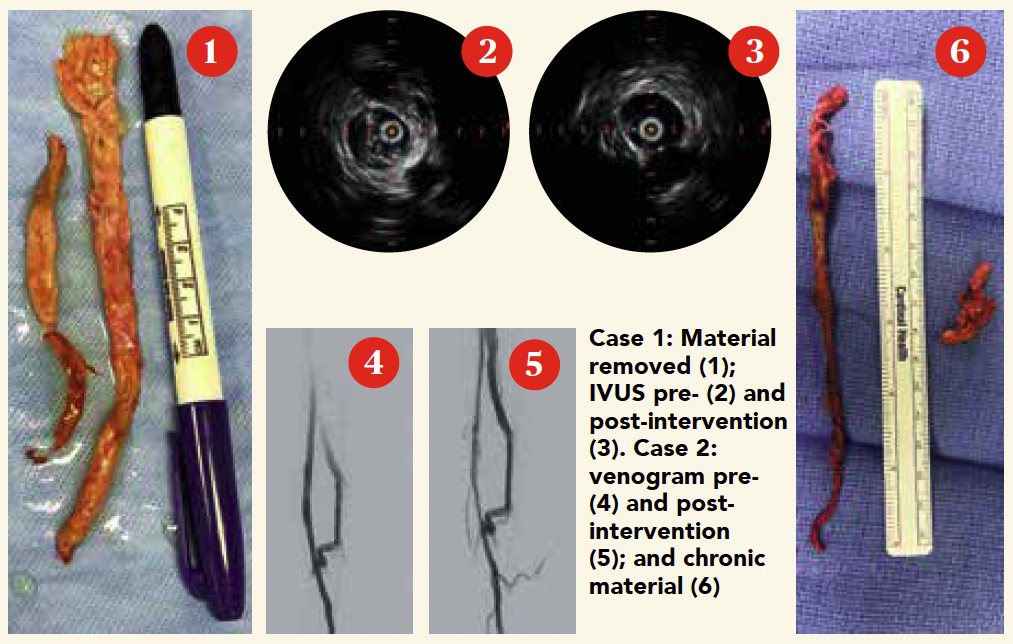
This advertorial is sponsored by Inari Medical.
Despite the recent growth in mechanical thrombectomy devices for acute deep vein thrombosis (DVT), interventional options for wall adherent venous obstruction are extremely limited. Residual venous obstruction after medical or interventional therapy for the treatment of acute DVT is associated with an increased incidence of post-thrombotic syndrome (PTS).1,2 Managing venous obstruction and the associated symptoms at its initial onset remains a challenge for interventionalists. However, as Steven D. Abramowitz, MD, chair and director of vascular surgery for MedStar Health in Washington, D.C., says, a new technology—the VenaCore™ thrombectomy catheter (Inari Medical)—might be able to “change the care algorithm” for patients burdened by the long-term complications of venous obstruction.
“A revolutionary technology like VenaCore addresses a previously unmet procedural need and allows operators to remove venous occlusions from within the vein lumen,” he explains. “As an endovascular tool, it has enough engagement with venous obstruction to remove adherent clot from the vein wall, as well as force to grab post-thrombotic scar tissue. The unique design of the device allows for effective treatment of acute and chronic pathology without harming the vein wall. VenaCore is the first FDA [Food and Drug Administration]- approved device that is designed to address challenging venous occlusions in a wide variety of patients.”
The ClotTriever® (Inari) Outcomes (CLOUT) registry demonstrated that mechanical thrombectomy using the ClotTriever system can have similar procedural success regardless of newly diagnosed DVT chronicity.2 However, removing refractory wall-adherent material can still be challenging. Balloon maceration or other adjuvant techniques can be of limited success. When used with the ClotTriever system, VenaCore can target focal treatment areas of underlying venous obstruction that may reduce the severity of associated complications.
Residual venous outflow obstruction is not only associated with a higher future risk of DVT and pulmonary embolism (PE), but also has a significant impact on a patient’s Villalta score, as well as their venous disease-related disability and quality-of-life outcomes. The pain associated with PTS can be “pretty severe, and lifestyle-limiting,” Abramowitz states, citing venous claudication, ulceration and trophic skin changes as notable symptoms.
“While I utilize VenaCore to improve outcomes in acutely presenting patients, the other patients who benefit from VenaCore-assisted thrombectomy are symptomatic patients who have venous occlusions that are challenging to treat”, says Abramowitz. Many DVT patients are relegated to compression therapy once symptoms begin. For those eligible for iliofemoral stent placement, femoropopliteal inflow disease can limit the likelihood of long-term stent durability and patency.
According to Abramowitz, many PTS patients with poor inflow suffer from poor long-term stent patency outcomes. Balloon venoplasty has therefore represented the most frequent intervention for primary and secondary-assisted patency, but this approach itself is associated with an incredibly “high rate of recurrence” and “very short-lived results.”
“We were doing these procedures with great frequency, with little or no return,” he recalls. “That’s because, as much as you want to balloon the scar tissue ‘out of the way’ in the femoropopliteal segment, all you’re doing is shifting something that’s solid to the side—and it bounces back. It’s not like arterial disease, which can remodel around a treated segment. Venous disease and post-thrombotic scar do not positively remodel.”
Such a lack of interventional options and physicians’ subsequent inclination towards more conservative management has created a huge array of patients who, historically, have disengaged from their vascular specialists and had minimal contact with healthcare beyond that initial recommendation. In Abramowitz’s view, the situation has created a “really unique physician-patient interaction”—both in terms of treatment opportunities and re-education. The VenaCore device represents a leading solution that may ameliorate things for interventionists treating patients with a history of venous disease.
He highlights three distinct patient groups who can now be addressed and for whom the device may open doors: those with prior iliofemoral or femoropopliteal DVT treated with anticoagulation alone with persistent symptoms; those whose stents failed as a result of poor inflow; and those in whom stents would otherwise have been contraindicated due to poor inflow, which can now be restored to allow for iliofemoral stenting.
“VenaCore on its own, and in conjunction with RevCore™ [Inari], truly disrupts all of our current care algorithms when it comes to venous occlusions that are difficult to treat,” Abramowitz says, alluding to the disconcerting fact that many providers have historically been reticent to offer intervention, or even follow-up management in the outpatient setting. “It was essentially seeing somebody every three to six months when you had nothing to offer them. VenaCore not only disrupts the interventional algorithm, but also the care algorithm for these patients, revitalizing and reengaging those patients who’ve been told there are no options.”
VenaCore case report 1
A man in his late 40s was diagnosed with an extensive iliofemoral DVT while traveling five months prior to outpatient consultation with severe symptoms, despite anticoagulation therapy. Mechanical thrombectomy with ClotTriever, despite adjuvant manoeuvres, was only partially successful at removing highly-wall adherent thrombus. VenaCore was used to mobilize additional material within the vein for a technically optimal result.
 VenaCore case report 2
VenaCore case report 2
A woman in her early 60s who has had PTS for many years presented to the office with hemosiderosis and atrophic blanche. An ultrasound in the femoral vein showed a post-thrombotic scar related to a prior femoropopliteal DVT. The patient was brought in for intervention with VenaCore and underwent a successful procedure with no complications.
References
- Iding AFJ et al. Residual venous obstruction as an indicator of clinical outcomes following deep vein thrombosis: A management study. Thromb Haemost. 2023 Aug
- Dexter D et al. Safety and effectiveness of mechanical thrombectomy from the fully enrolled multicenter, prospective CLOUT registry. JSCAI. 2023 March
Disclosure: Steven D. Abramowitz is a paid consultant of Inari Medical. All views and opinions expressed here by Abramowitz are his own and do not represent those of Inari Medical.
Indications For Use: The ClotTriever Thrombectomy System in indicated for the (1) non-surgical removal of thrombi and emboli from blood vessels (2) injection, infusion and/or aspiration of contrast media and other fluids into or from a blood vessel. The ClotTriever Thrombectomy System is intended for use in the peripheral vasculature, including deep vein thrombosis (DVT). The VenaCore Thrombectomy Catheter is indicated for (1) The non-surgical removal of thrombi and emboli from blood vessels. (2) Injection, infusion, and/or aspiration of contrast media and other fluids into or from a blood vessel. The VenaCore Thrombectomy Catheter is intended for use in the peripheral vasculature. The RevCore Thrombectomy Catheter is indicated for (1) The non-surgical removal of thrombi and emboli from blood vessels. (2) Injection, infusion, and/or aspiration of contrast media and other fluids into or from a blood vessel. The RevCore Thrombectomy Catheter is intended for use in the peripheral vasculature.
Caution: Federal (USA) law restricts this device to sale by or on the order of a physician. Refer to Indications for Use for complete Indications for Use, contraindications, warnings and precautions. For Indications for Use of non-Inari products, please refer to the manufacturer. All copyrights and trademarks are property of their respective owners.












